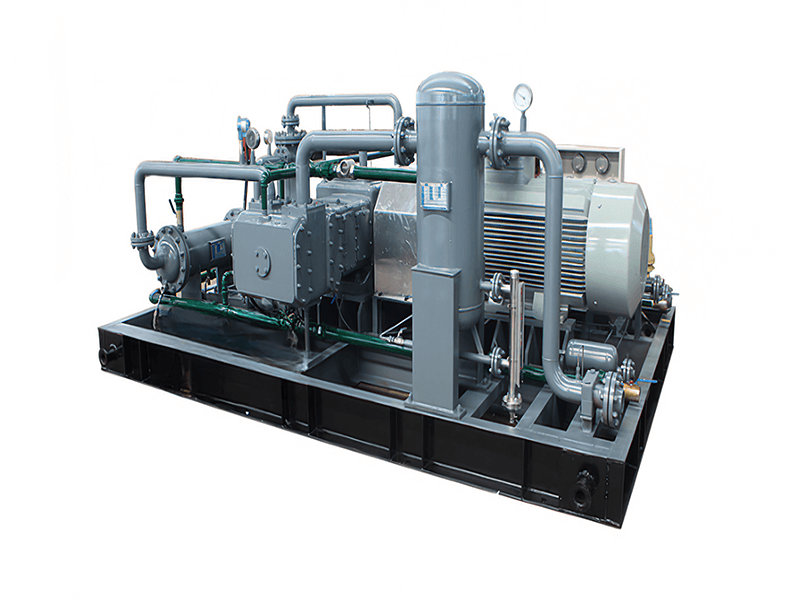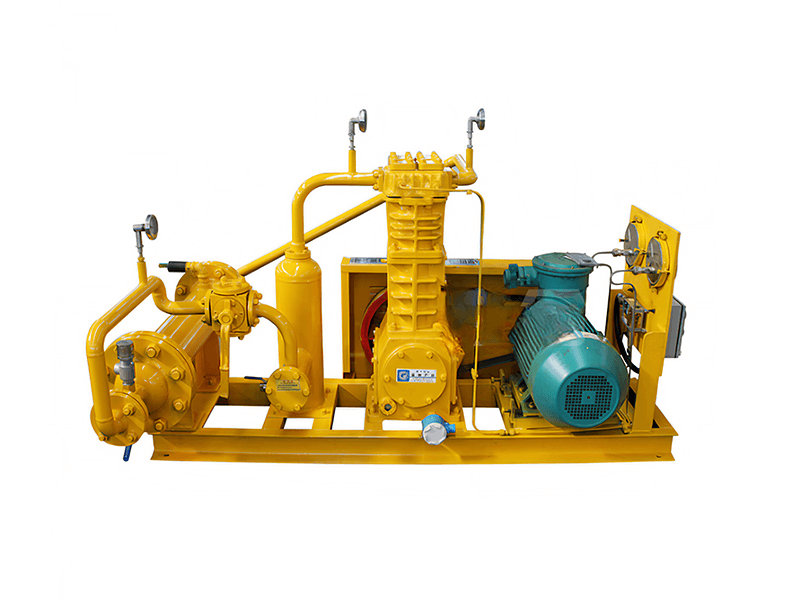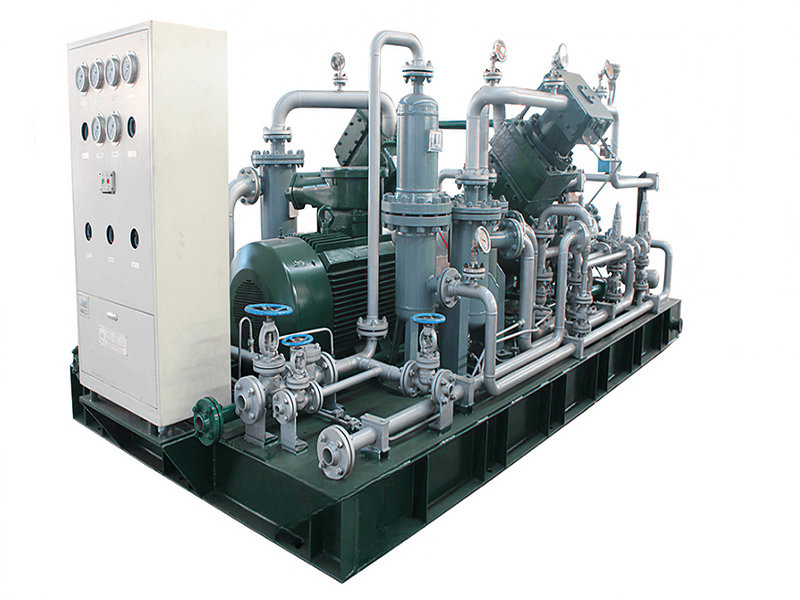Natural gas boosting plays a significant role in various industries and applications. Here are some key points highlighting the significance of natural gas boosting:
1. Pressure Enhancement: Natural gas boosting is used to increase the pressure of the gas, ensuring its efficient transportation through pipelines. Boosting the pressure helps overcome frictional losses and maintain an adequate flow rate over long distances, enabling the gas to reach its destination reliably.
2. Pipeline Transmission: Natural gas is a widely used energy source for heating, electricity generation, and industrial processes. Boosting the pressure of natural gas allows for efficient transmission through pipelines, enabling the gas to be transported from production sites to distribution centers or end-users across vast distances.
3. Enhanced Efficiency: By increasing the pressure of natural gas, its energy density is enhanced, enabling more energy to be stored in a given volume. This increased energy density allows for more efficient storage and transportation, reducing the need for larger storage tanks or transportation vessels.
4. Power Generation: Natural gas boosting is essential for power generation applications. Natural gas-fired power plants utilize turbines that require high-pressure gas for efficient combustion and electricity production. Boosting the gas pressure ensures optimal performance and efficiency of these power plants.
5. Industrial Processes: Many industrial processes, such as chemical manufacturing, metal refining, and glass production, rely on natural gas as a fuel or feedstock. Natural gas boosting ensures a consistent and reliable gas supply to these processes, enabling efficient and continuous operations.
6. Gas Compression Stations: Gas compression stations are crucial infrastructure facilities along natural gas pipelines. These stations use natural gas boosting equipment to compress the gas and maintain the required pressure levels for pipeline transportation. Boosting the gas pressure at these stations allows for seamless gas flow and distribution.
7. Renewable Energy Integration: Natural gas boosting also supports the integration of renewable energy sources, such as wind and solar power, into the electrical grid. Natural gas turbines can be used as backup or peaking power sources to provide reliable electricity during periods of low renewable energy generation or high demand.
8. Liquefied Natural Gas (LNG): Natural gas boosting is essential in the liquefaction process of natural gas, where the gas is cooled and compressed to convert it into a liquid state for storage and transportation. Boosting the gas pressure is a crucial step in preparing natural gas for LNG export or storage.
9. Natural Gas Vehicles (NGVs): Natural gas is used as a fuel for vehicles, particularly in compressed natural gas (CNG) or liquefied natural gas (LNG) form. Natural gas boosting is necessary to provide the required pressure for fueling NGVs, ensuring efficient and reliable operation of the vehicles.
10. Remote Locations and Offshore Platforms: Natural gas boosting is crucial in remote locations and offshore platforms where access to gas supplies may be challenging. By boosting the gas pressure, it becomes feasible to transport natural gas to these areas, enabling the provision of energy for various purposes, including power generation and heating.
11. Peak Shaving: Natural gas boosting is employed in peak shaving applications, where additional gas supply is required during periods of high demand. By boosting the gas pressure, stored gas reserves can be released and delivered to meet peak demand, helping to stabilize the energy grid and ensure a consistent energy supply.
12. Gas Storage: Natural gas boosting is essential for gas storage facilities. By boosting the pressure, natural gas can be injected into underground storage reservoirs, allowing for efficient storage during times of low demand. When demand increases, the stored gas can be withdrawn by reducing the pressure, ensuring a reliable supply even during peak periods.
13. Gas Distribution Networks: Natural gas boosting is utilized in gas distribution networks to maintain consistent pressure levels throughout the system. Boosting stations along the distribution network help regulate the pressure and ensure that gas reaches end-users reliably, whether for residential, commercial, or industrial purposes.
14. Backup Power Generation: Natural gas boosting is significant in backup power generation systems. Natural gas-powered generators can provide backup electricity during power outages or emergencies. Boosting the gas pressure ensures that the backup power system is ready to deliver electricity when needed, providing critical support for essential services and facilities.
15. Environmental Benefits: Natural gas is considered a relatively cleaner fossil fuel compared to coal or oil. By enabling efficient transportation and utilization of natural gas through boosting, the environmental impact of energy generation and industrial processes can be reduced. Natural gas combustion produces fewer greenhouse gas emissions and air pollutants, contributing to improved air quality and reduced carbon footprint.
16. Industrial Heating: Natural gas is widely used for industrial heating applications, such as in furnaces, boilers, and kilns. Boosting the gas pressure ensures a consistent and reliable fuel supply, enabling efficient and precise control of heating processes in industries like manufacturing, food processing, and pharmaceuticals.
17. Combined Heat and Power (CHP) Systems: Natural gas boosting is crucial for combined heat and power systems, also known as cogeneration systems. These systems generate electricity and capture waste heat for heating or other industrial processes. By boosting the gas pressure, CHP systems can efficiently produce both electricity and heat, maximizing energy utilization and reducing overall energy consumption.
18. District Heating: Natural gas boosting plays a significant role in district heating systems, where a centralized heat source supplies heat to multiple buildings or residential areas. Boosting the gas pressure allows for the efficient distribution of natural gas as a fuel for heat generation, ensuring reliable and cost-effective heating for a large number of consumers.
19. Chemical Feedstock: Natural gas is a valuable feedstock for the production of various chemicals, such as ammonia, methanol, and hydrogen. Boosting the gas pressure ensures a consistent supply of natural gas for these chemical processes, supporting the production of essential industrial chemicals used in various sectors, including agriculture, transportation, and manufacturing.
20. Economic Impact: The availability and reliability of natural gas supply through boosting have significant economic implications. Natural gas is a cost-effective energy source, and boosting ensures its efficient utilization across industries, leading to increased energy affordability, improved industrial competitiveness, and economic growth. Moreover, natural gas production and associated infrastructure development create jobs and stimulate economic activity in regions rich in natural gas resources.
21. Backup for Renewable Energy: Natural gas boosting provides a reliable backup for intermittent renewable energy sources, such as wind and solar power. When renewable energy generation fluctuates or drops, natural gas power plants can quickly respond to meet the energy demand, ensuring grid stability and mitigating the challenges posed by the variability of renewable energy sources.
22. Research and Development: Natural gas boosting continues to be an area of research and development, aiming to enhance efficiency, reduce emissions, and improve overall performance. Ongoing advancements in boosting technologies, such as advanced compressors and control systems, contribute to the continuous improvement of natural gas utilization and its integration with emerging energy systems.
23. Energy Security: Natural gas boosting plays a crucial role in ensuring energy security for nations. By boosting the gas pressure, countries can enhance their capacity to import and store natural gas, reducing their dependence on volatile international energy markets. This helps diversify energy sources and provides a reliable and stable energy supply, contributing to energy security and reducing geopolitical risks.
24. Greenhouse Gas Emissions Reduction: Natural gas boosting can contribute to reducing greenhouse gas emissions. Natural gas is a cleaner-burning fuel compared to coal and oil, resulting in lower carbon dioxide emissions when used for power generation or heating. By boosting natural gas pressure and promoting its use, countries can transition away from more carbon-intensive fuels, supporting efforts to mitigate climate change.
25. Rural Energy Access: Natural gas boosting can facilitate access to clean and affordable energy in rural areas. By extending natural gas pipelines and implementing boosting stations, remote communities can benefit from the availability of natural gas for heating, cooking, and other energy needs. This helps improve living conditions, reduce reliance on traditional biomass fuels, and promote economic development in rural regions.
26. Decentralized Energy Systems: Natural gas boosting enables the development of decentralized energy systems. By utilizing natural gas in smaller-scale power generation units, such as microturbines or fuel cells, communities and businesses can generate their own electricity and heat locally. This promotes energy independence, resilience, and the integration of distributed energy resources into the grid.
27. Industrial Competitiveness: Natural gas boosting enhances the competitiveness of industries reliant on energy-intensive processes. By providing a cost-effective and efficient energy source, natural gas enables industries to reduce production costs, increase productivity, and remain competitive in the global market. This is particularly relevant for sectors like steel, cement, and petrochemicals.
28. Research and Innovation: The development of natural gas boosting technologies drives research and innovation in the energy sector. Advancements in compressor design, control systems, and efficiency optimization techniques contribute to the continuous improvement of natural gas boosting systems, leading to energy savings, reduced emissions, and enhanced operational performance.
29. Energy Transition Support: Natural gas boosting can serve as a transitional energy source during the shift to a low-carbon future. As renewable energy technologies continue to advance, natural gas can complement intermittent renewables by providing flexible and dispatchable power generation. This allows for a smoother transition toward a more sustainable energy mix.
30. International Cooperation: Natural gas boosting encourages international cooperation and partnerships in the energy sector. Countries with natural gas resources can export gas and collaborate with importing nations by developing infrastructure, sharing expertise, and fostering economic ties. Such collaborations promote energy security, economic growth, and diplomatic relations.
These additional points highlight the wide-ranging significance of natural gas boosting, encompassing aspects such as energy security, emissions reduction, rural energy access, innovation, and international cooperation. Boosting natural gas pressure enables the utilization of this versatile energy source to meet diverse energy needs while driving sustainable development and addressing global energy challenges.
The method of natural gas boosting
The method of natural gas boosting typically involves the use of compressors to increase the pressure of the gas. Here's an overview of the process:
1. Gas Compression: The natural gas is first collected from production wells and processed to remove impurities, such as water, sulfur compounds, and other contaminants. The processed gas is then ready for compression.
2. Compressor Types: Various types of compressors can be used for natural gas boosting, including reciprocating compressors, centrifugal compressors, and screw compressors. The selection of the natural gas booster compressor type depends on factors such as the required pressure increase, gas flow rate, and specific application.
3. Reciprocating Compressors: Reciprocating compressors use a piston-cylinder arrangement to compress the gas. The gas enters the cylinder, and as the piston moves, it compresses the gas by reducing the volume. Reciprocating compressors are commonly used for smaller-scale applications and when high compression ratios are required.
4. Centrifugal Compressors: Centrifugal compressors use a rotating impeller to accelerate the gas and convert kinetic energy into pressure. The gas enters the compressor through an inlet, and the impeller imparts high rotational speed to the gas, causing it to move outward and increase in pressure. Centrifugal compressors are suitable for high flow rate applications and large-scale gas boosting.
5. Screw Compressors: Screw compressors use two interlocking screws to compress the gas. The gas is trapped between the rotating screws and the compressor housing, and as the screws move, the gas is compressed along the length of the screws. Screw compressors are known for their efficiency and are often used in natural gas boosting applications.
6. Compressor Station: Compressors are typically housed in compressor stations, which serve as centralized facilities along natural gas pipelines or at production sites. These stations may contain multiple compressors operating in parallel to meet the required pressure and flow rate.
7. Ancillary Equipment: Natural gas boosting systems may include various ancillary equipment, such as coolers or heat exchangers to manage the temperature of the gas during compression, filtration systems to remove particulate matter or contaminants, and control systems to monitor and regulate the compressor operation.
8. Pressure Regulation: Depending on the specific requirements of the gas transmission or application, the boosted gas pressure may be regulated at certain points along the pipeline or prior to entering the end-use equipment or processes.
9. Multi-Stage Compression: In cases where a significant boost in gas pressure is required, multi-stage compression is employed. This involves passing the gas through multiple compressor stages, with each stage providing a partial pressure increase. The gas is compressed in successive stages, allowing for higher overall pressure ratios to be achieved.
10. Intercooling: Intercooling is a technique used in gas compression to manage the temperature rise during the compression process. In multi-stage compression, intercoolers are placed between the stages to cool down the gas before it enters the next stage. This helps improve compressor efficiency and reduces the power consumption of the system.
11. Gas Conditioning: Prior to compression, natural gas may undergo conditioning processes to ensure its suitability for compression and transportation. This may involve removing any remaining impurities, adjusting the gas composition, or reducing the moisture content. Gas conditioning helps protect the compressor equipment and ensures the efficient operation of the gas boosting system.
12. Gas Transmission Pipelines: Natural gas boosting is commonly implemented in gas transmission pipelines to maintain adequate pressure levels for efficient gas flow over long distances. Boosting stations are strategically located along the pipeline to compensate for pressure losses that occur due to friction and other factors. The compression at these stations allows the gas to overcome these losses and continue flowing smoothly.
13. Control and Automation: Natural gas boosting systems incorporate advanced control and automation technologies to ensure safe and optimized operation. Control systems monitor key parameters such as gas flow rate, pressure, and temperature, and adjust the compressor operation accordingly. Automation allows for remote monitoring and control, enabling operators to manage the gas boosting system efficiently.
14. Safety Measures: Safety is a paramount consideration in natural gas boosting. Systems are designed and operated in accordance with industry standards and regulations to mitigate risks associated with high-pressure gas handling. Safety features such as pressure relief valves, emergency shutdown systems, and gas leak detection systems are implemented to protect personnel and equipment.
15. Maintenance and Monitoring: Regular maintenance and monitoring of the boosting equipment are essential to ensure reliable and efficient operation. This includes periodic inspections, lubrication, and replacement of parts as needed. Monitoring systems are employed to assess the performance and health of the compressors, allowing for proactive maintenance and minimizing downtime.
16. Energy Efficiency: Energy efficiency is a key focus in natural gas boosting systems. Efforts are made to optimize compressor design, improve system integration, and reduce energy losses. This includes measures such as selecting the appropriate compressor type, optimizing compressor speed, and implementing energy recovery systems to utilize waste heat generated during compression.
17. Environmental Considerations: Natural gas boosting systems strive to minimize environmental impact. Efforts are made to reduce fugitive emissions, ensure proper disposal of any captured impurities, and comply with environmental regulations. Additionally, advancements in compressor technology aim to enhance efficiency and reduce greenhouse gas emissions associated with natural gas compression.
These additional points provide further insights into the method of natural gas boosting, highlighting aspects such as multi-stage compression, intercooling, safety measures, energy efficiency, and environmental considerations. By employing these techniques and adhering to best practices, natural gas boosting systems can operate effectively, with a focus on reliability, safety, and sustainability.


























